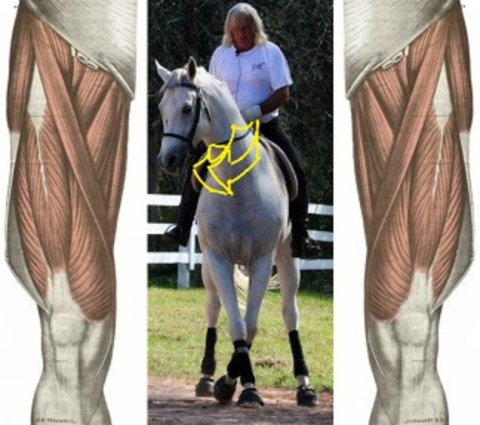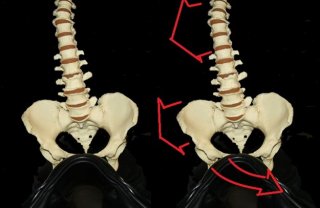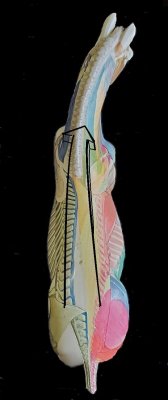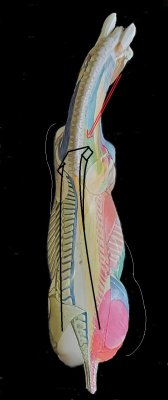The rider's upper thighs
The rider's upper thighs
The secret of the equestrian art
Jean Luc Cornille
The horse bends the thoracic vertebrae bends between the rider's upper thighs. Physically, it is easy to bend the horse's thoracic spine between our upper thighs. We have to face the direction of the bend, maintaining the integrity of our body, including our upper thighs. This does not demand extraordinary skill, or strength, or intensive training. When it does not work, it is because we focus on the upper thighs instead of the integrity of our whole physique.

Our ancestors summarized the equitation into aids. It was a step toward actual knowledge that explicates that efficiency does not rely on the accuracy of our hands or leg's action, but instead on our whole physique's integrity. Our brain maps our bodies all at once. Even if we concentrate on one area of our physique, our proficiency relies on our integrity, our ability to nuances muscle tone within subtle coordination of our entire body. It is not the dexterity of our fingers that creates lightness; it is the stability of our seat, our ability to measure the contact of our calves, our faculty to orchestrate the work of the horse's back muscles through our back and abdominal muscles, and our aptness at not taking back with the hands.
There are many reasons why a horse would not turn right or left as we face right or left. Some reasons come from the horse's muscle imbalance or other issues. However, this discussion is about the rider and what in our physique could alter the efficiency of a move functionally easy.
One of the reasons is our hands. Even if we concentrate on not turning with our hands, our central pattern generators are used to the reflex, and we unconsciously contract one forearm, ease the other, or push on the horse's shoulders with the outside rein. It looks doubtful that a contraction in our forearms could alter the contact of our upper thighs. Yes, if we think at the level of body parts. No, if we take conscience that the horse converses with us at the level of tensegrity, tension or muscle tone and integrity of our whole physique.
Our ancestors believed that they could bend the horse's thoracolumbar spine with a rein effect. With actual knowledge and experience, I believe that in reality, the horses felt and followed the slight orientation of the rider's body in the direction of the move. I was trained to use the rein effects, but functional anatomy demonstrated that bending the cervical spine was not necessarily related to the thoracic spine's bending. Indeed, when the phenomenon of transversal rotation was explained, it becomes evident that most rein effects induce inverted rotation.
I took conscience gradually that my horses bent their thoracic spine in response to a slight rotation of my body. I explored the observation and realized that they were more sensitive and comfortable with a conversation based on the tone and orientation of my torso and upper thighs than my hands. With practice, I refined the conversation, identifying and eliminating the nuisances.
One of the nuisances was the theory of shifting our weight on one seat bone. The dynamic effect contradicted the benefit of the body alignment. Whatever the shift was on the inside or outside seat bone, my body weight induced a lateral shift of the horse body that contradicted the dynamic of bending. Lateroflexion is a forward concept where the thrust of the hind legs is managed forward through the thoracolumbar spine by the muscular system and directed right of left by our body's orientation, including our upper thighs.
In this illustration, the rider is seated on the right seat bone, and the spine is bent to the left.  If the horse is on a circle or shoulder-in, or half pass right, the bending of the rider's vertebral column and the weight on the inside seat bone will push the horse toward the right. However, as the dynamic effect of the hind and front limbs change at each instant, it will be moments where the weight on the inside seat bone will push the horse's body toward the outside of the bend.
If the horse is on a circle or shoulder-in, or half pass right, the bending of the rider's vertebral column and the weight on the inside seat bone will push the horse toward the right. However, as the dynamic effect of the hind and front limbs change at each instant, it will be moments where the weight on the inside seat bone will push the horse's body toward the outside of the bend.
In this illustration, the rider is seated on the right seat bone, and the spine is bent to the left. If the horse is on a circle or shoulder-in, or half pass right, the bending of the rider's vertebral column and the weight on the inside seat bone will push the horse toward the right. However, as the dynamic effect of the hind and front limbs change at each instant, it will be moments where the weight on the inside seat bone will push the horse's body toward the outside of the bend.
In this picture, the weight is on the left seat bone, and the thoracic spine is twisted toward the left (white arrow.)
The twist of the thoracic spine has been created for the picture. The same twist is made riding the horse when we rotate our shoulders more than our pelvis.
This torsion is often created when we turn using the hands or simply the reflex of contracting one forearm and easing the other as we do when we turn with the hands.
Our body and upper thighs' efficiency is altered by our hand's action or even the memory of the hand's action. It is not muscle memory as traditionally stated. Bad habits depend almost entirely on how the premotor and parietal areas act as coaches and shape the commands coming from the motor cortex. The good news is that bad habits can be unlearned. The bad news is that it demands at first high concentration.
Bending the area of the horse's thoracolumbar spine situated between the rider's upper thighs, using the rider's upper thighs, is irrefutable logic. It became the only efficient way when science demonstrates that lateral bending of the thoracic spine is always coupled with a transversal rotation shifting the dorsal spines toward the inside of the bend. 
Lateral bending is a forward phenomenon where the hind legs' thrust is converted forward through the thoracolumbar spine into lateroflexion and transversal rotation.
When the force coming from the hind legs is directed forward and around the rider's inside leg by the rider's back, pelvis, and upper thighs, the transversal rotation is likely to be correct.
If there is a resistance of the hands or a backward action of our inside hand (red arrow,) the spine rotation is likely to be inverted, shifting the shoulders to the left and the haunches to the right.
Our hands should not cut the movement and never the less act backward. The science of motion uses the term "filter." The holes of a filter can be larger or smaller according to how much we want to go through. The analogy makes us think about filtering with the fingers, but this interpretation is too much about the hands. The dynamic of the whole body is the filter, including the forearms and the fingers.
Facing right or facing left is not physically difficult. The difficulty is evolving from the application of gestures to an equitation of harmonic tensegrity, subtle nuances in muscle tone involving our body as a whole. I don't describe the move as advancing the outside shoulder or moving the inside shoulder bac or advancing the outside hip. These body part explanations keep riders in the equitation of gestures. James Rooney summarized the principles of traditional equitation. " The proper functioning of the locomotor system depends on the precise synchronization of the movement of each part on every other part and in relation to the body as a whole." (James R. Rooney) Rooney is the first to say that the theory is just theoretical. Each part works in relation to the body as a whole, not just precise synchronization of each part's movement on every other part. The tension of the forearms alters the steadiness and efficiency of our upper thighs. Instead of starting with body parts and trying to orchestrate a functional physique, it is necessary to think about the body all at once. Our nervous system maps our body all at once and yet achieves precise control of one area. A muscle never works alone. A rider's action can never be limited to one hind leg. There is a coordination of the thoracolumbar spine, which eases or alters one hind leg's adduction. The upper thighs are probably the most influential part of the rider's physique but as part of the rider's physique and not just the upper thighs.
Jean Luc Cornille


 twitter
twitter facebook
facebook google
google pinterest
pinterest linkedin
linkedin